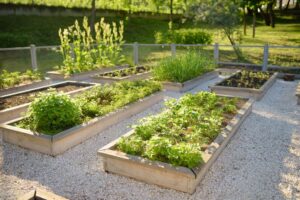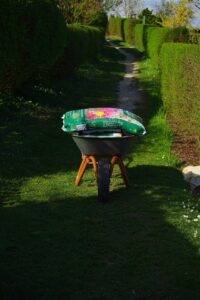DIY Soil Mix for Raised Garden Beds

Gardening is a great way to connect with nature and produce food for yourself and your family. If you are like me and have to do raised bed gardening because of poor soil you will need a good DIY soil mix. People underestimate the importance of soil in providing essential nutrients and other benefits to plants. This is where a DIY soil mix come in – by allowing gardeners to customize their soil composition according to their specific plant needs. Understanding the science and components of DIY soil mixes for raised garden beds is key to successful raised garden bed gardening.
Components of DIY Soil Mixes
DIY soil mixes typically include compost, peat moss/coconut coir, and perlite/vermiculite. The proportion of each component can vary depending on the desired outcome of the mix. Compost is a great source of slow-release nutrients and organic matter, which helps to improve soil structure and aeration. Peat moss or coconut coir provides additional aeration and can help retain moisture in the soil mix. Finally, perlite/vermiculite are used for drainage since they are both highly porous and lightweight materials. Generally, these are mixed in proportions of 1/3 each
Another option is to use 50% garden soil, 30% compost and 20% sand for drainage as a base and add ingredients specific to what you are growing. For instance, blueberries would need an acidifier added to this mix.
My favorite way if you have the time is a sort of lasagna method. Lay down a layer of cardboard, followed by straw, sprinkle on a thin layer of blood meal and bone meal, top with compost and repeat until your bed is full. The top layer is compost with a straw mulch on top. This makes a rich worm-filled soil as it breaks down.
For this article though we will stick with the typical compost, peat moss and perlite mix. Just be aware there are other options.

DIY Soil Mixes For Vegetables
Vegetable plants generally require more nutrients than other types of plants. Therefore, it is important to ensure that your soil mix is tailored according to the nutritional needs of these vegetables. A typical vegetable soil mix should consist of 40-50% compost or any other nutrient-rich material, 30-40% peat moss/coconut coir, and 10-20% perlite/vermiculite for drainage. If the mix is too heavy, adding more perlite/vermiculite will help lighten it up and make it easier to work with.
DIY Soil Mixes For Flowers
Flowers often require a soil mix that is lighter in texture than other plants since they tend to have a shallow root system. A good flower soil mix should consist of 60-70% compost, 20-30% peat moss/coconut coir, and 10-20% perlite/vermiculite for drainage. This type of mix will ensure that the flowers are able to obtain enough nutrients while also providing proper drainage so the roots do not get waterlogged.
DIY Soil Mixes For Cacti and Succulents
Cacti and succulents require a soil mix that is well-draining, so it is important to choose components that will help prevent the soil from becoming soggy or retaining too much moisture. A good cacti/succulent soil mix should include 70-80% sand/gravel, 10-20% perlite/vermiculite for drainage, and 10-20% compost or other nutrient-rich material. This type of mix will ensure that the plants’ roots have enough room to breathe while also providing the necessary nutrients for healthy growth.
DIY Soil Mixes For Trees and Shrubs
Trees and shrubs require a soil mix that is nutrient-dense but still allows for good drainage. A typical tree/shrub soil mix should consist of 40-50% compost or any other nutrient-rich material, 20-30% peat moss/coconut coir, and 30-40% sand/gravel for drainage. This type of mix will provide the necessary nutrients while helping to prevent waterlogging.
DIY Soil Mixes For Mediterranean Herbs
Mediterranean herbs require a soil mix that is light and airy, and one that also provides good drainage. A typical Mediterranean herb soil mix should consist of 50-60% peat moss/coconut coir, 30-40% compost or any other nutrient-rich material, and 10-20% perlite/vermiculite for drainage. This type of mix will ensure that the herbs can obtain enough nutrients while also providing proper drainage for their roots.
DIY Soil Mixes For Tomatoes and Peppers
Tomatoes and peppers require a soil mix that is nutrient-rich with good moisture retention. A typical tomato/pepper soil mix should consist of 40-50% compost or any other nutrient-rich material, 20-30% peat moss/coconut coir for moisture retention, and 30-40% sand/gravel for drainage. This type of mix will ensure that the plants’ roots have access to the necessary nutrients while also providing proper drainage and sufficient moisture.
DIY Soil Mixes For Berries
Berries require a soil mix that is nutrient-rich with good drainage but also has enough moisture retention for their delicate berries. A typical berry soil mix should consist of 40-50% compost or any other nutrient-rich material, 20-30% peat moss/coconut coir for moisture retention, and 30-40% sand/gravel for drainage. This type of mix will ensure that the berries can access the necessary nutrients while also providing proper drainage and sufficient moisture for their delicate fruits. Most berries need more acidic soil, so it’s important to make sure that the soil mix contains soil acidifier. I lost all my blueberry plants until I figured that out. Below is a link on Amazon for what i use on my blueberry patch now. This stuff works! No more dead blueberry bushes! You just mix a few TBS in a 5 gallon bucket and pour on your bushes. I use it on the strawberry plants too. It seems to make both very happy. Give it a try if your blueberries are dying like mine were.
DIY Soil Mixes For Citrus Trees
Citrus trees require a soil mix that is nutrient-rich but also provides better drainage than most other plants. A typical citrus tree soil mix should consist of 40-50% compost or any other nutrient-rich material, 20-30% peat moss/coconut coir for moisture retention, and 30-40% sand/gravel for drainage. This type of mix will ensure that the citrus trees can access the necessary nutrients while also providing proper drainage and sufficient moisture for their delicate fruits. As with berry plants, it’s important to consider adding soil acidifiers when creating the mix for citrus trees as they require a more acidic soil than most other plants.
DIY Soil Mixes For Root Crops
Root crops require a soil mix that provides both enough nutrition and sufficient drainage to support their needs. A typical root crop soil mix should consist of 40-50% compost or any other nutrient-rich material, 20-30% peat moss/coconut coir for moisture retention, and 30-40% sand/gravel for drainage. This type of mix will ensure that the root crops can access the necessary nutrients while also providing proper drainage and sufficient moisture.
Adding organic matter such as composted manure, leaf mulch, or straw is recommended to provide additional nutrition and structure for the roots. The addition of well-aged manure or compost can help increase nutrient availability for root crops.
DIY Soil Mixes For Melons and Gourds
Melons and gourds require a soil mix that is both moist and nutrient-rich. A typical melon/gourd soil mix should consist of 40-50% compost or any other nutrient-rich material, 20-30% peat moss/coconut coir for moisture retention, and 30-40% sand/gravel for drainage. Adding organic matter such as composted manure, leaf mulch, or straw will help improve the soil structure and increase nutrient availability for melons and gourds.
It’s important to consider adding soil acidifiers when creating the mix for these plants as they require a more acidic soil than most other plants. Additionally, the addition of well-aged manure or compost can help increase nutrient availability for melons and gourds.
The Process of Mixing Your DIY Soil Mix
Once you decide which mix is best for your needs, it’s important to properly prepare the mix for planting. Start by blending all of the materials in a large bucket, container or tarp until everything is evenly mixed. After this step, you can add any additional soil amendments as desired. Once the mix is complete, it’s ready to be shoved into your raised bed or pot for planting!
DIY soil mixes are an effective and economical way to create a nutrient-rich growing environment for planting. With the right mix of materials and soil acidifiers, your plants can thrive when planted in your own soil mix!
How to Maintain Your DIY Soil Mix
It’s important to keep your soil mixes well maintained throughout the season. A few simple steps can help you achieve better results from your soil mix.
- Regularly monitor the moisture levels and adjust accordingly as needed. A moisture meter will help you determine if additional watering is necessary.
- Make sure to keep an eye out for any pests or diseases that may be present in your soil mix. If found, take appropriate action to remove the problem from your environment.
- Feed your plants regularly with a balanced fertilizer to ensure they receive all of the essential nutrients they need to thrive.
- Perform regular soil tests to check for any imbalances in pH or nutrient levels and adjust accordingly.
- Always use high-quality ingredients when creating your mixes. Avoid using subpar materials that may not be beneficial to your plants.
- Research the best amendment combinations for each type of plant you are growing in order to create a customized soil mix tailored to its needs.
- Make sure to use proper aeration techniques when mixing your ingredients so there is adequate air flow through the soil.
- Regularly add organic material to your mix to keep it healthy and fertile.
With these tips in mind, you can create the perfect soil mix for your plants! Happy gardening!
Conclusion
This article aims to provide gardeners with useful information on creating and maintaining DIY soil mixes. By following the tips outlined in this article, you can ensure that your soil mix is healthy and productive. Don’t forget to regularly monitor the pH levels of your soil, add organic material as needed, and use high-quality ingredients when creating your mix! With just a bit of effort, you can create an amazing home garden for yourself.
For more on raised bed gardening check here.
For more on how to compost click here.
For more on using compost in the garden click here.
References:
Soil Amendment Guide, Planet Natural Research Center https://www.planetnatural.com/soil-amendment-guide/
Soil Types and Plant Nutrients, University of Maryland Extension https://extension.umd.edu/resource/soil-fill-raised-bedshttps://extension.umd.edu/resource/soil-fill-raised-beds
Understanding Soil Acidity & Alkalinity, Planet Natural Research Center https://www.planetnatural.com
